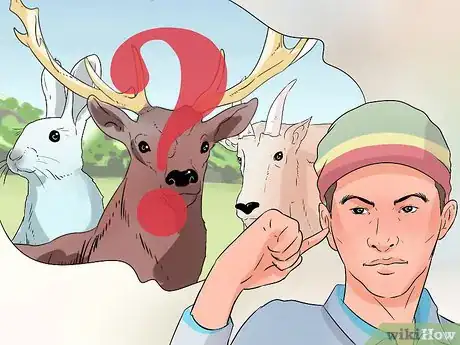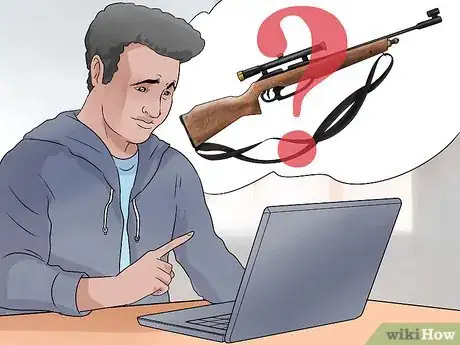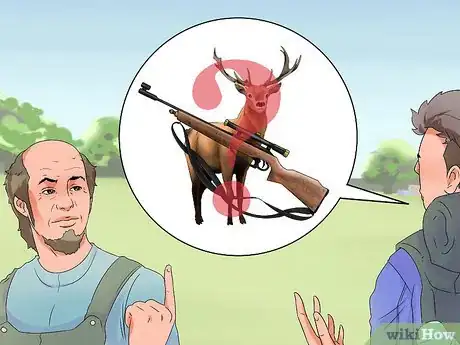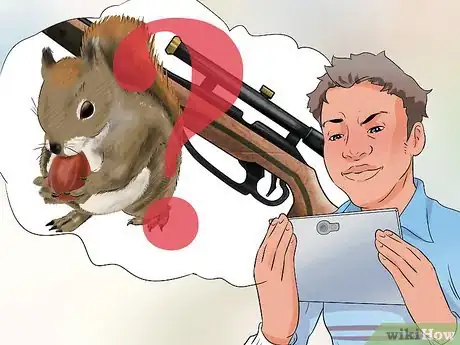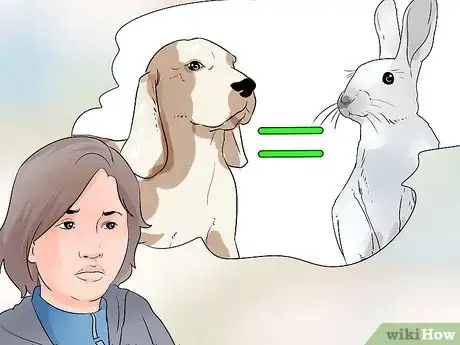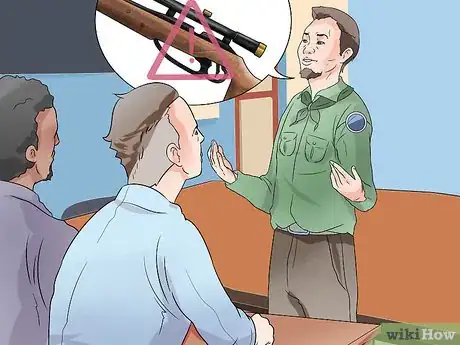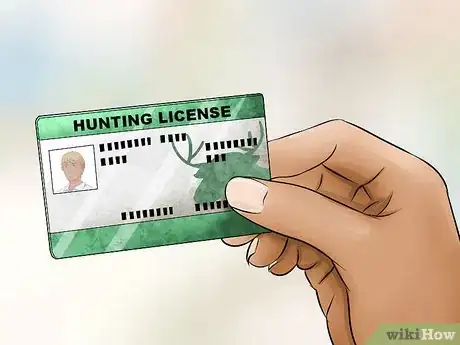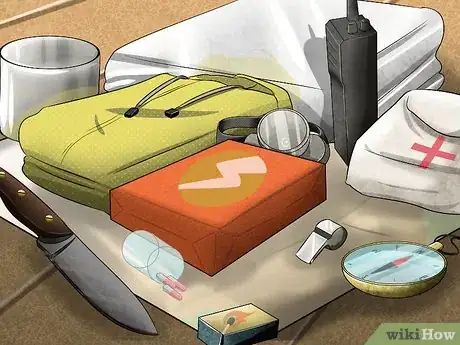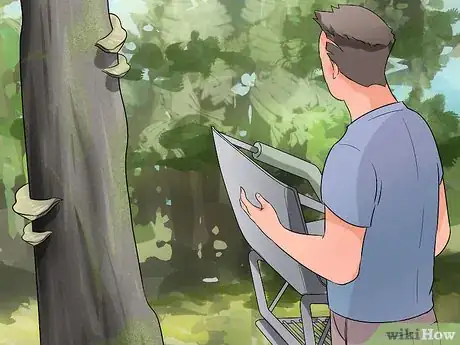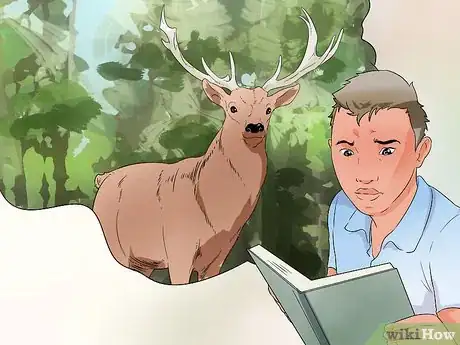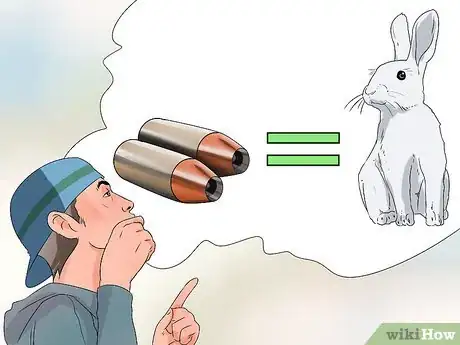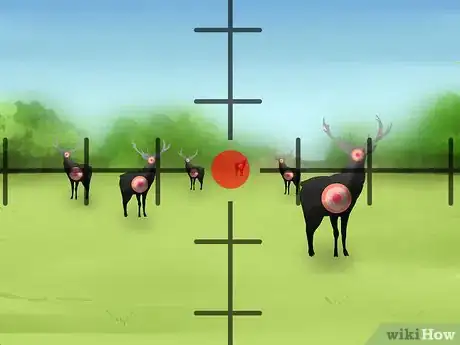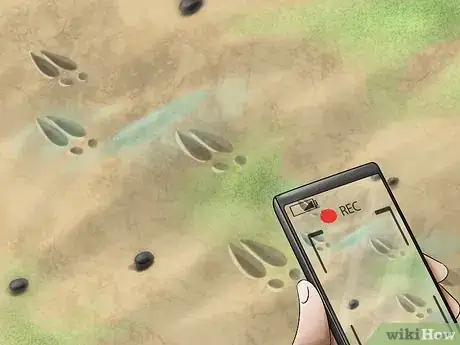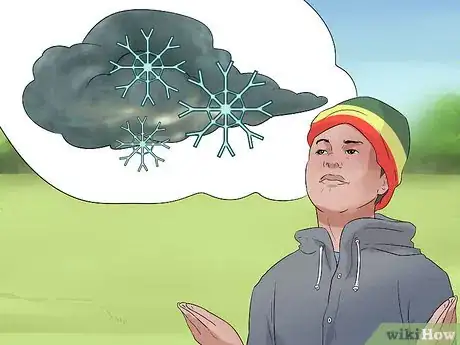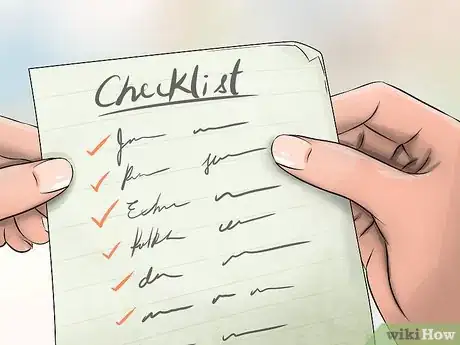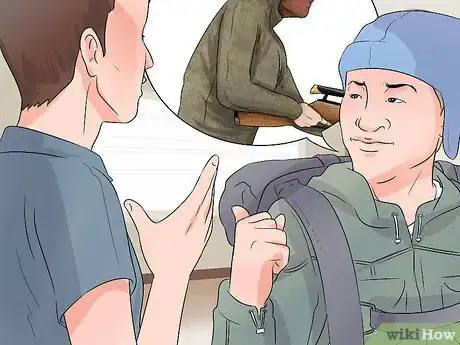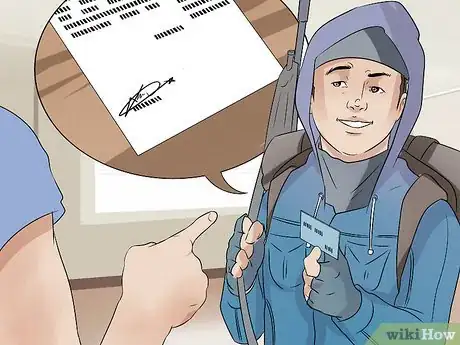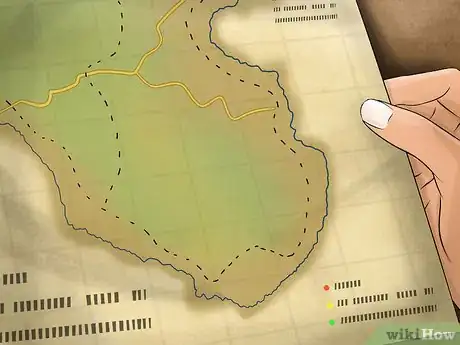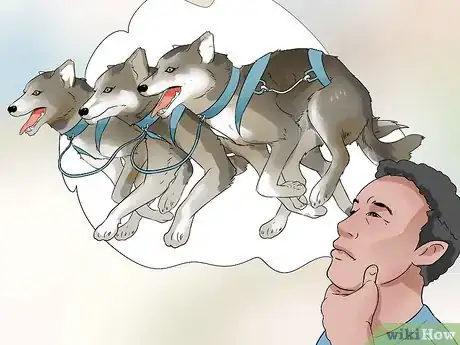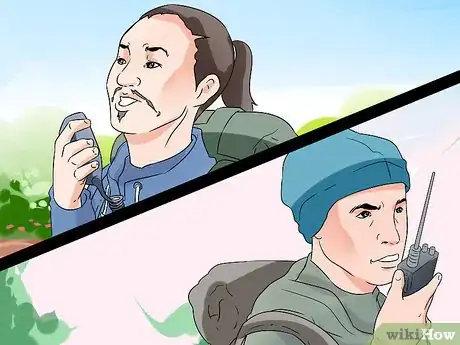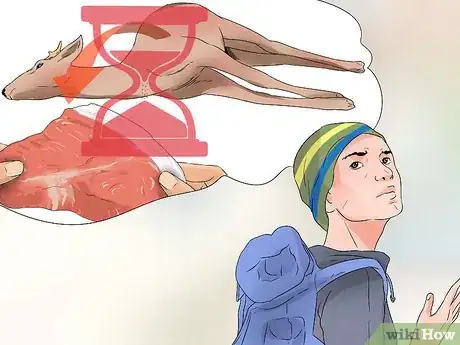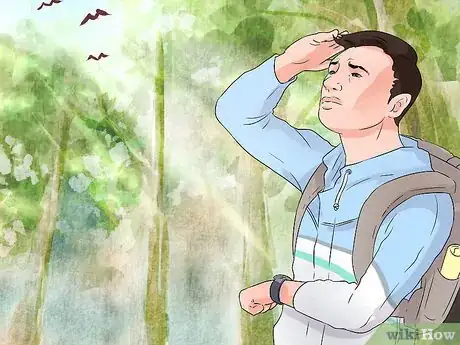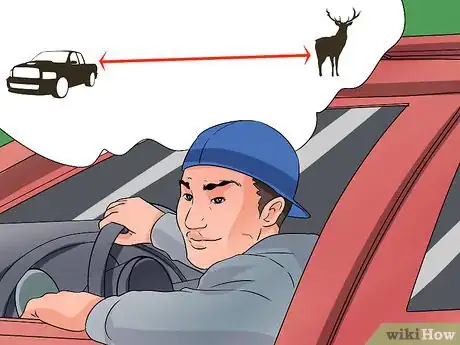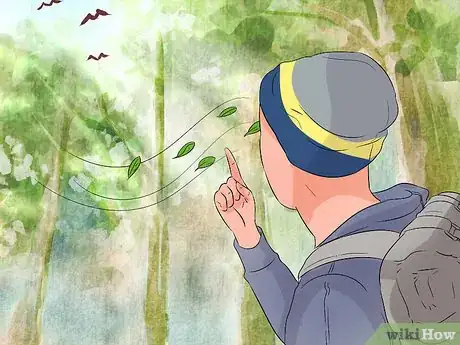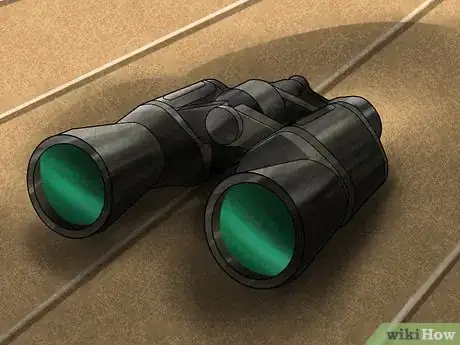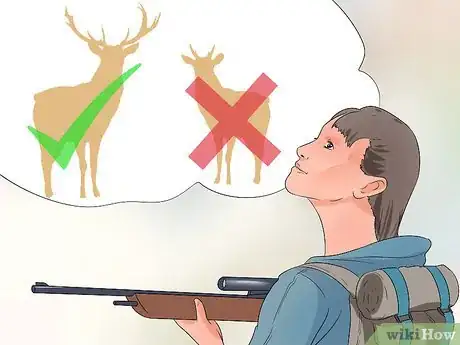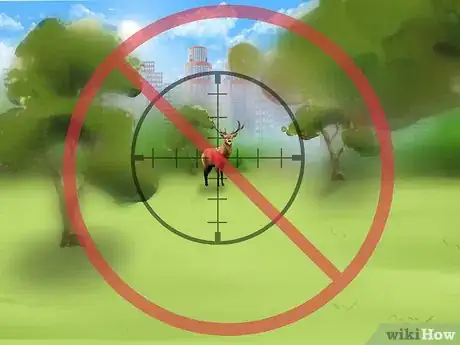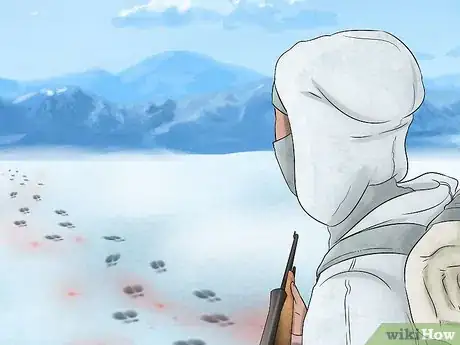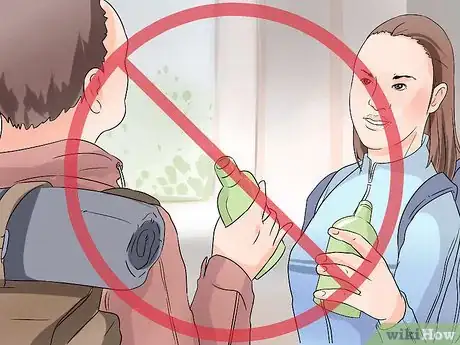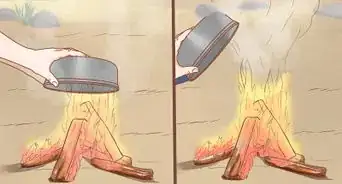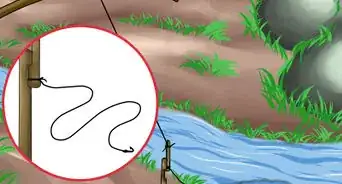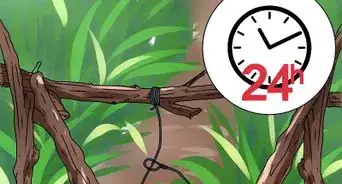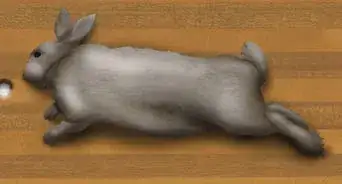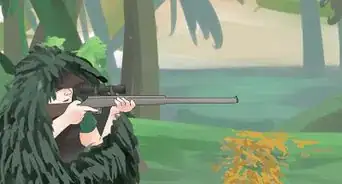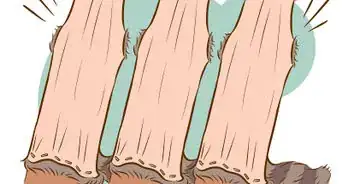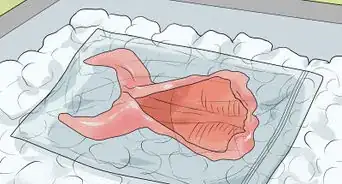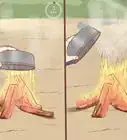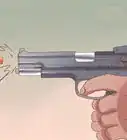wikiHow is a “wiki,” similar to Wikipedia, which means that many of our articles are co-written by multiple authors. To create this article, 71 people, some anonymous, worked to edit and improve it over time.
There are 32 references cited in this article, which can be found at the bottom of the page.
This article has been viewed 119,214 times.
Learn more...
Hunting is an effective way of controlling the populations of animals that no longer have other predators. It also procures a very healthy meat source in a way that is environmentally appropriate. It is important to have proper training and preparation. This will enable you to keep yourself and others safe as you hunt, as well as reducing the suffering of the animals you kill.
Steps
Researching Hunting
-
1Decide on your preferred game. "Game" refers to the kind of animal you will be hunting. The game you decide to hunt will influence the methods you employ while hunting, the kind of weapon or trap with which you hunt, and where will be best for you to hunt.[1] Some ideas on what to hunt:
- Small animals, like rabbit, hare, squirrel, pheasant, crow, waterfowl, etc.
- Big animals, like deer, sheep, moose, antelope, bear, bighorn sheep, mountain goat, etc.
-
2Research effective hunting tools. You won't need an elephant gun to hunt a pheasant, but there are likely a few different guns paired with birdshot that can be used for pheasant hunting. Research the best weapon best suited for the species you have chosen to hunt.[2] Some weapons to consider:
- Bow and arrow
- Shotgun
- Black powder rifle
- Rimfire rifle
- Centerfire (high-powered) rifle
Advertisement -
3Talk to someone with hunting experience. Ask among your family members or inquire with workers at your local sporting goods store for someone who could answer some questions you have about hunting. You might say:
- "I don't have a lot of hunting experience, but I really like nature, and I could benefit from the nutrients in venison. Could you tell me a little bit more about deer hunting?"
-
4Investigate state and local restrictions and regulations. Depending on where you live, how rural the country is, and the local culture, there can be significant differences in the legal definitions of various kinds of game and the acceptable weapons you can use to hunt.
- Most locations have a Department of Natural Resources, Fish and Wildlife Department or similar organization that regulates hunting in the area. A quick online search should help you find the relevant agency charged with wildlife management.
-
5Look into hunting tactics for your game. The right hunting tactic will give you even more enjoyment from the sport by offering you the most reasonable chance for success on your hunt. Some common hunting tactics include:
- Deer hunting may be done from ground blinds, tree stands, stalking, or by driving prey from brush or cover with a group. Some areas even allow pursuing deer with hounds.
- Upland birds are often hunted with dogs like pointers or setters, which can actually follow the scent of these game birds. Then, these hunting dogs will point out the prey for the hunter to flush and shoot.[3]
- Migratory birds are often hunted from blinds, so a successful bird hunter will need to find a feeding area or watering area to hunt. Harvested grain fields, waterways, or other places may offer successful hunts for these birds.
- Small game, like rabbits and squirrels, may be hunted using dogs. Beagles are a favorite for rabbits, and some breeds are easy to train for treeing squirrels (or raccoon or opossums).
Preparing to Hunt
-
1Take necessary safety courses. Many states and areas require you to take a mandatory course in hunter's safety before you can be issued a hunting license, especially when hunting with a gun. Be sure you comply with all regulations, or else you could be fined or suffer other legal consequences, like incarceration.[4]
-
2Purchase a license, if necessary. Depending on the area in which you live, you may be able to hunt some animals, like small game, without a permit as long as you adhere to your region's hunting regulations.
-
3Put together emergency supplies. While you are hunting, an accident might occur that may require medical attention, or you might have to spend the night in the elements waiting for help to arrive. Don't be caught unprepared. Make sure you have:
- Extra daily medication (e.g. insulin, blood pressure pills, etc.).
- Cell phone or two way radio (in waterproof case).
- Appropriate clothing for changeable weather (rain gear, etc.).
- Lighters/fire starters.
- Metal cup.
- Waterproof light source (e.g. headlamp).
- Whistle or signaling device.
- Emergency shelter (e.g. space blanket).
- Survival knife.
- First aid kit.
- Emergency rations (granola, meal replacement bars, etc.).
- Map and compass.
-
4
-
5Practice your hunting tactic. If you plan to hunt from a portable tree stand, you will want to be familiar with carrying and climbing with it before your hunt. The same applies for fashioning a blind, or for the procedure for stalking game.
-
6Choose a location. Your prey will likely have an ideal habitat. Here you will have a better chance of finding your prey while you hunt. Research the ideal habitat of your prey, paying attention to notes about migration and yearly changes in behavior, and find some locations near you where you can hunt your game.
- Hunting on public land is legal, so long as it is not in violation of state, federal or regional restriction, you have the proper licenses, and you are following state, federal or other applicable hunting regulations.
Becoming Familiar with Your Weapon
-
1Decide the ammunition appropriate for your animal. You will need enough knock down power for a quick and clean kill, but not so much as to do extensive damage to the animal's meat. Here are some examples:
- Quail, dove, and other small birds can be killed with shotguns using shot sizes between size six and nine in field loads, using gauges from 20 ga. to 12 ga.
- Turkeys, geese, grouse, ducks, pheasants, etc require larger shot sizes, and preferably larger gauge guns. A 12 ga. or even 10 ga. shooting number two or number four shot is a good choice.[8] [9] [10] [11]
- Rabbits and squirrels can be hunted with rim fire rifles using hollow point bullets, high powered air rifles shooting at least 750 fps, or shotguns similar to those used for quail and dove.[12]
- Deer, antelope, and sheep can be killed with center fire rifles, bows, or muzzle loading rifles. Center fire cartridges should be at least .243 caliber with no smaller than 100 grain soft pointed bullets. Muzzle loading rifles should be at least .40 caliber, and bows should be capable of shooting a broad head arrow capable of delivering a clean kill.[13] [14] [15]
- Larger game, like elk, wild boar, moose, or bear, can be shot and killed with larger calibers, such as .30 caliber guns shooting 150 or higher grain soft pointed bullets. Dangerous game hunting requires a gun capable of bringing down charging animals.[16]
-
2Give yourself a "sight" advantage. Modern bows can be equipped with peep sights, pin sights, illuminated or even telescopic sights. Shot guns usually only have a front bead, although slug guns may have rifle type iron sights, or in some cases laser dot sights. Rifles can be equipped with telescopic sights, iron sights, peep sites, red dot sights, or in some cases, combinations of these.[17] [18]
-
3Understand the action or configuration of your weapon. There are single shot, double barreled, pump action, semi automatic rifles and shot guns, each with potentially different mechanisms of action.[19] The same goes for bows: there are re-curve, compound, or cross bows.[20] Some people even hunt with pistols. Use a weapon you are capable of handling with confidence.
-
4Practice with your weapon of choice. You should do this until you are confident in your (and its) ability to do the job. You may want to visit a rifle or bow range, a skeet range, or some other shooting facility. You should take your shooting seriously if you plan on being successful.
Planning for a Good Hunt
-
1Familiarize yourself with the terrain. It's best to do a walkabout of the area you will be hunting in so you know the areas in which your game are likely to bed down. This will also give you the advantage if you hit your prey but have to track it.
- Take note of any swamps, loose rocks, fallen trees, or any other obstacles that might impede your route to your hunting location.
- Be aware of natural animal runs through your hunting area. These are frequently the paths your chosen game will travel, and if you have to track your prey, knowing these will be helpful.
- Memorize or take a picture of the tracks you see on these natural trails. When you return home, you can check these against a track guide.[21]
-
2Check the weather conditions. It's best to be prepared for bad weather when you go out hunting, even if the weather report calls for fair weather. Knowing ahead of time about inclement weather or other dangerous conditions can save your life.[22]
-
3Gather your supplies. Forgetting something when you are out in the wilderness can be more than inconvenient: it can be dangerous. You should make a checklist and gather the things you will need before going on the hunt.
- In addition to the emergency supply kit you put together while preparing to hunt, you should also be sure you are wearing an appropriate amount of blaze orange (also called hunter's orange or safety orange) so that other hunters can see you.
-
4Inform friends and family of your plans. This way, if you get lost or are the victim of a hunting accident, you will know that help will eventually be on the way. In the wilderness, you can't always rely on a cellphone to get you the help you need.
-
5Get permission, if necessary. If you are hunting on the private property of a friend or neighbor, you must be sure you have the landowner's permission and your hunting license before setting out to hunt.
- It's always best to give your neighbor a warning before heading out to hunt, even if you've been told you can hunt there anytime. This will limit your chances for hunting accidents.
-
6Review your map. This will jog your memory from the walkabout you took in preparation to your hunting excursion. This will also remind you of the best route to get there and safest path to your hunting location.
Learning About Handling Your Game
-
1Learn proper game meat handling. This will change according to the game you are hunting. However, field dressing and hauling a 700 pound elk is not something you want to try without preparation. Take the time to learn what must be done with an animal to avoid wasting the meat you have taken.
-
2Make sure you have resources for caring for the meat. You may need pack animals or other means to haul a large game animal. You should also keep in mind that you will need a place to store potentially several hundred pounds of venison, moose, or elk after your hunt is over.
-
3Network with other hunters. This can be useful for developing hunting partners, but can also help in the event that you don't have sufficient freezer space. You can also get tips on how to [Field Dress a Deer Carcass] and prepare the meat.
-
4Understand time is a factor. A trophy buck might be tempting to drive around and show off, but if the weather is mild, you need to gut the animal and cool the meat as quickly as possible after it is taken.[23] Other game animals have special handling requirements as well.
Going on Your Hunt
-
1Begin the hunt at an appropriate time. This will depend entirely on your game and regional restrictions. Evening stand hunting for deer may require you to arrive at your stand in mid afternoon. This way the wildlife will calm from your interruption and your scent will dissipate before your game is most active.
-
2Enter the hunting area as quietly as possible. You should park your vehicle a considerable distance from the area in which you expect to encounter game, then proceed to your chosen stand or stalking area as quietly as possible.
-
3Stop frequently to observe your surroundings. For many beginner hunters, the hardest part about getting wild meat is sitting quietly for hours while waiting for the right animal to walk into your sight. You will be looking for signs, such as droppings, tracks, evidence of foraging, or other indications your game is active in the area.[26]
-
4Be mindful of wind conditions while you hunt. High winds often cause game to hide in thick cover or bedding areas, since the wind will make detecting threatening predators more difficult. Wind also may carry your scent to your game, resulting in spooked animals who will flee long before you get near them.[27]
-
5Use binoculars or a spotting scope. This is especially useful when hunting open country so you can scan for game.[28] You may find you only see a tip of an antler, or the eye of a well-camouflaged rabbit. Once the animal spooks and runs, it will be difficult to get an accurate shot.
-
6Be certain of your target before shooting. Deer and other animals are a renewable meat resource, but number that can be killed each year is not unlimited. Many species of game have restrictions on the size or sex of the animal you are hunting.[29] Be familiar with local regulations, and make sure your target complies with them.
-
7Shoot for a clean kill. As an ethical meat eater, you are now taking firsthand responsibility for the sacrifice of life that must be made to help sustain your own. Once you have identified a meat animal that is safe for you to shoot, strive to get the animal down as quickly and painlessly as possible. You should avoid shooting a game animal that is too far away, moving too quickly for you to properly sight, or is in a position where a miss could result in injury to other hunters or property.[30] If you are not sure of the background, do not shoot. Don't shoot toward or across highways, and never shoot toward buildings or populated areas.
-
8Be prepared to track and dispatch a wounded animal. If you do not make a clean kill on what you plan to eat, wait a decent amount of time before following and tracking it down because even wounded animals can run for miles if they suspect that they are being chased. However, it is ultimately your responsibility to make every effort to find the wounded animal and humanely end its suffering.[31] This may mean tracking through rough terrain, patiently looking for blood or other signs showing you the direction of travel until you have found your prey.
-
9Practice safe group hunting procedure. If you decide on hunting with a friend or friends, be sure they are also attired in an appropriate amount of blaze orange and that they stay in sight while hunting.
- Check your gear before returning home; you don't want to bring potentially harmful wild animals into your home by accident.
- Do not indulge in alcohol or use drugs while hunting, as this may compromise your judgement and lead to injury.
- Test all your equipment before going out on your hunt. The last thing you want is faulty equipment putting you or you hunting partner(s) in danger.[32]
Community Q&A
-
QuestionIf I see a dead animal, would it be best to stay away?
 Community AnswerYes, as it could mean other hunters are among them, and they may accidentally shoot you. Or predators would be around, depending on the size of the game.
Community AnswerYes, as it could mean other hunters are among them, and they may accidentally shoot you. Or predators would be around, depending on the size of the game. -
QuestionWould a bow and arrow be effective in small game, such as a rabbit, and most importantly, would it make a clean kill?
 Community AnswerYes, although most people do hunt small game with a small caliber rifle or air rifle, it can be fun and rewarding to hunt small game with a bow and arrow. Try to refrain from using field points as they do not always cause great tissue damage and can cause the game to be injured rather than killed. Purchase a specialty small game point to cause greater tissue damage and cause the game to bleed out quickly, making for a quick clean kill.
Community AnswerYes, although most people do hunt small game with a small caliber rifle or air rifle, it can be fun and rewarding to hunt small game with a bow and arrow. Try to refrain from using field points as they do not always cause great tissue damage and can cause the game to be injured rather than killed. Purchase a specialty small game point to cause greater tissue damage and cause the game to bleed out quickly, making for a quick clean kill. -
QuestionHow do I hunt in a zombie apocalypse?
 Majesta BarneyCommunity AnswerThe same as you would normally, except that the laws and permits you'd normally have to observe probably wouldn't apply in a zombie apocalypse. You would just want to be extra careful not to hurt yourself and that whatever you hunt doesn't attract unwanted attention and whatever you eat isn't spoiled.
Majesta BarneyCommunity AnswerThe same as you would normally, except that the laws and permits you'd normally have to observe probably wouldn't apply in a zombie apocalypse. You would just want to be extra careful not to hurt yourself and that whatever you hunt doesn't attract unwanted attention and whatever you eat isn't spoiled.
Warnings
- Never point a weapon at something unless you are planning to kill it. Even an unloaded weapon should be treated with respect.⧼thumbs_response⧽
- Know the law. Hunting certain species without buying tags first can lead to a steep fine and/or prison in some locations.⧼thumbs_response⧽
- Be aware of local predators while hunting. These are sometimes attracted to your kill, and can be dangerous if you are unaware.⧼thumbs_response⧽
- Always exercise caution while climbing down from stands with any weapons.⧼thumbs_response⧽
- Make sure your tree stands or blinds are secure before taking anything up.⧼thumbs_response⧽
- Always wear the right clothing and footwear for the climate and terrain.⧼thumbs_response⧽
Things You'll Need
- Ammunition
- Appropriate clothing for changeable weather (rain gear, etc.)
- Blaze orange clothing (a.k.a. hunter's orange or safety orange)
- Cell phone or two way radio (in waterproof case)
- Emergency rations (granola, meal replacement bars, etc.)
- Emergency shelter (e.g. space blanket)
- Extra daily medication (e.g. insulin, blood pressure pills, etc.)
- First-aid kit
- Hunting tags/license (it is illegal to hunt certain species without these)
- Lighters/fire starters
- Map and compass
- Metal cup
- Survival knife
- Water purification tablets
- Waterproof light source (e.g. headlamp)
- Weapon
- Whistle or signaling device
References
- ↑ https://www.biggamelogic.com/ArticlesNews/tabid/136/articleType/ArticleView/articleId/228/Deer-Hunting-Tips-For-Beginners.aspx
- ↑ http://www.outdoorlife.com/photos/gallery/guns/2011/05/best-hunting-rifles-decade
- ↑ http://www.ultimateupland.com/
- ↑ https://tpwd.texas.gov/regulations/outdoor-annual/hunting/general-regulations/laws-penalties-restitution
- ↑ http://www.tractorsupply.com/know-how_Hunting_different-methods-of-hunting
- ↑ http://www.sportsmensalliance.org/news/whats-right-about-hunting-with-hounds/
- ↑ https://www.bowhunter.com/editorial/spot-and-stalk-the-art-of-hunting-on-foot/183171
- ↑ http://www.fieldandstream.com/photos/gallery/guns/shotguns/ammunition/2011/07/fss-ultimate-shotshell-guide/?image=2
- ↑ http://www.fieldandstream.com/photos/gallery/guns/shotguns/ammunition/2011/07/fss-ultimate-shotshell-guide/?image=3
- ↑ http://www.fieldandstream.com/photos/gallery/guns/shotguns/ammunition/2011/07/fss-ultimate-shotshell-guide/?image=18
- ↑ http://www.fieldandstream.com/photos/gallery/guns/shotguns/ammunition/2011/07/fss-ultimate-shotshell-guide/?image=19
- ↑ http://www.fieldandstream.com/articles/guns/shotguns/2004/10/perfect-small-game-gun
- ↑ http://www.fieldandstream.com/node/1005010717
- ↑ http://www.furfishgame.com/featured_articles/Archived/2010-06/gun_rack_06_2010.php
- ↑ http://survival-mastery.com/skills/scouting/best-arrows-for-hunting.html
- ↑ http://www.offthegridnews.com/survival-hunting/the-4-very-best-calibers-for-hunting-big-game/
- ↑ http://www.fieldandstream.com/blogs/whitetail-365/2013/06/does-single-small-sight-pin-improve-bow-accuracy
- ↑ http://www.fieldandstream.com/articles/guns/rifles/2014/06/complete-guide-riflescopes
- ↑ http://www.fieldandstream.com/photos/gallery/guns/rifles/shooting-tips/2011/07/guide-rifle-actions-bolt-lever-pump-and-semi-auto
- ↑ http://www.huntersfriend.com/traditional_bow_selection_guide/traditional_bow_selection_guide.html
- ↑ http://www.oyccweb.com/uploads/2/6/4/4/26442920/animal_track_id_guide.pdf
- ↑ http://www.travelinsurancereview.net/tips-and-advice/planning-your-trip/prepare-hunting-trip-us/
- ↑ http://wildlife.ohiodnr.gov/portals/wildlife/pdfs/publications/hunting/pub111.pdf
- ↑ http://wildlifeartcreations.net/trophy-field-care.html
- ↑ https://www.americanhunter.org/articles/2018/11/12/how-to-skin-a-rabbit-in-30-seconds/
- ↑ https://outdooraction.princeton.edu/nature/guide-animal-tracking
- ↑ http://www.fieldandstream.com/node/1005011054
- ↑ http://www.wildernessunlimited.com/ed-migale/hunting-optics-binoculars-1.html
- ↑ https://tpwd.texas.gov/regulations/outdoor-annual/regs/animals/white-tailed-deer
- ↑ http://www.adfg.alaska.gov/index.cfm?adfg=hunting.shot
- ↑ http://kb.rspca.org.au/How-do-recreational-hunters-kill-deer-and-is-it-humane_545.html
- ↑ http://www.travelinsurancereview.net/tips-and-advice/planning-your-trip/hunting-safety-tips/
About This Article
Before you hunt, get a local license if it’s required, and make sure you have outerwear in “hunter’s orange,” which makes you visible to other hunters. Then, move as quietly as possible when you go into the hunting area, so you don’t spook the game. You should use binoculars to scan for game, then pay attention when you find a target to ensure it’s the game you’re hunting. Once you’re certain of your target and feel like you have a good, clean shot, then take it. Just be prepared to track and finish off the animal humanely if you don’t end up with a clean kill. For tips on how to choose the right weapon and ammunition for your hunt, keep reading!
